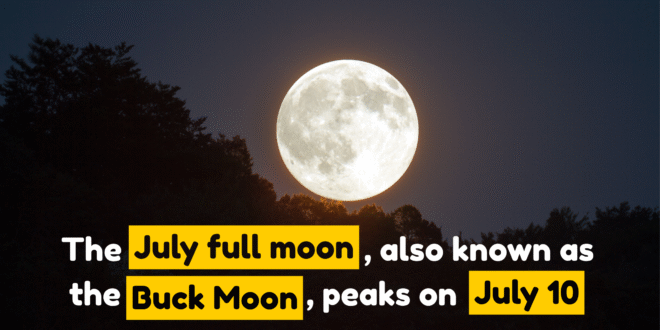The full moon of July 2025, commonly known as the Buck Moon, reaches its peak illumination on Thursday, July 10. According to lunar calendars, the moment of full Moon occurs around 4:37 p.m. (EDT / 2037 GMT)—though it will not be visible at that instant—in North America, while across central U.S. it corresponds to approximately 3:36–3:37 p.m. CDT.
Why “Buck Moon”? Origins and Names
The name “Buck Moon” stems from the seasonal growth cycle of male deer (bucks): this is when they regrow their antlers, symbolizing strength and renewal. It’s also referred to as the “Thunder Moon”, reflecting summer storm season, and carries alternative names like the “Hay Moon”, “Berry Moon”, or “Salmon Moon” in various cultural traditions.
Best Viewing Times & Visual Effects
Although the exact peak occurs in mid‑afternoon, the ideal viewing time is at moonrise, just after sunset on July 10. At that moment, the moon appears near the southeastern horizon, often glowing golden or reddish due to Rayleigh scattering, and appearing larger thanks to the “moon illusion.
Because the full moon follows shortly after Earth’s aphelion—its furthest point from the Sun—it will be the farthest full moon of 2025, and among the lowest-hanging full moons in the sky, especially influenced by a Major Lunar Standstill that occurs every 18.6 years.
Cultural & Astrological Significance
The Buck Moon coincides with significant observances in some traditions. In Hindu and Theravada Buddhist cultures, it aligns with Guru Purnima and Dharma Day, days dedicated to honoring teachers and reflecting on spiritual teachings.
Astrologically, the moon falls in Capricorn in 2025, opposite the Sun in Cancer. This alignment brings themes of ambition, legacy, emotional versus professional balance, and encourages reflection and structured change. Several astrology sources highlight that this energy urges focus, personal growth, and boundary-setting across zodiac signs.
Skywatching Tips & Surrounding Events
For optimal viewing, choose a dark, open horizon free from light pollution. The stunning alignment with Scorpius, featuring the star Antares and the Milky Way’s galactic core, offers rich opportunities for broader stargazing and astrophotography.
Beyond the Buck, July presents additional celestial events: the Alpha Capricornids meteor shower (active July 12–August 12, peaking late July), followed by the Perseids in mid-August. The upcoming Sturgeon is set for August 9. This full moon offers a vivid focal point in a month brimming with skywatching activity
Final Summary
- The Buck Moon 2025 reaches its peak on July 10, visible best after sunset at moonrise.
- Named for the regrowth of deer antlers, also called Thunder Moon and other traditional names.
- It’ll be the farthest full moon from the Sun in 2025, and especially low in the sky due to a Major Lunar Standstill.
- Culturally tied to Guru Purnima and Dharma Day; astrologically impactful under Capricorn’s pragmatic energy.
- Optimal viewing includes clear horizons and pairing with viewings of Scorpius and upcoming meteor showers.
Enjoy the celestial show—it’s a rare lunar spectacle blending natural beauty, cultural tradition, and cosmic timing.




